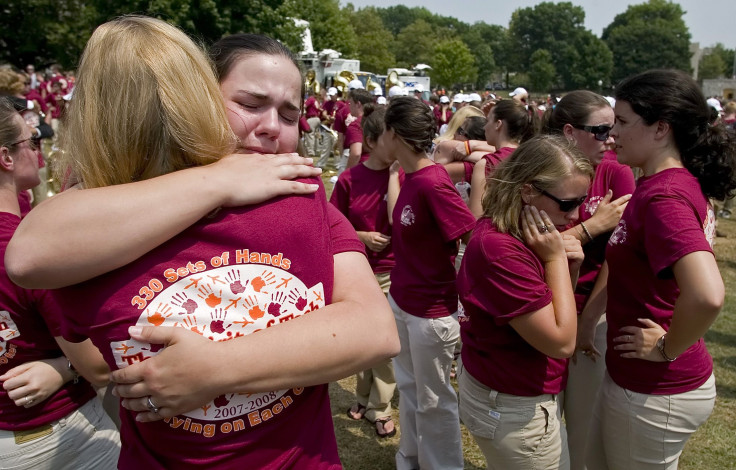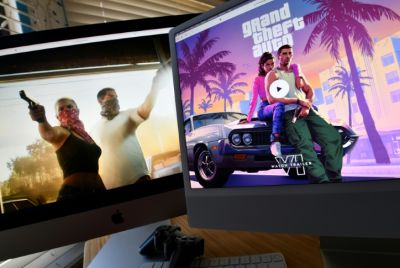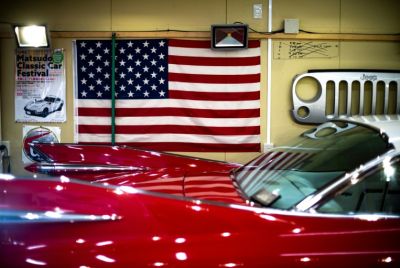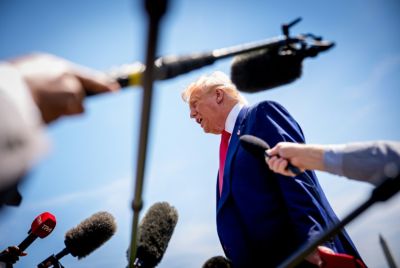Columbine, Virginia Tech Shootings Motivate Student Survivors, Parents To Fight School Violence

Crystal Woodman Miller hid under a table in the Columbine High School library on April 20, 1999, certain she would die. Seniors Dylan Klebold and Eric Harris had started shooting her classmates, and Miller was desperate to survive. As the gunmen left to reload, Miller saw her chance to run from the school. On the way out, she recalled the violence in an interview.
Later, when she got home, she gave another interview. And then another. The media kept calling, and Miller couldn’t turn anyone down. She felt a responsibility to share her story, especially because people were listening. “There was just a huge urgency because of what happened to me,” Miller said. “I would never want to see something like that happen to anyone else -- or anywhere else -- ever again.”
Klebold and Harris fatally shot 12 students and one teacher before killing themselves that day in Littleton, Colorado. Possible motives included bullying and religion but were never confirmed, and Columbine came to be known as the deadliest school shooting in U.S. history. Nearly a decade later, the Virginia Tech massacre claimed that title on April 16, 2007, when student Seung-Hui Cho slew 27 students and five faculty members on the Blacksburg, Virginia, campus. He also took his own life. Afterward, records revealed Cho had been ruled mentally ill by a judge.
Both incidents sparked national debate about gun control laws, mental health resources and school security. The 1999 shooting at Columbine and the 2007 massacre at Virginia Tech had another unintended consequence: They inspired survivors. The incidents turned a group of students with various aspirations -- as well as some of their family members -- into school safety advocates. Years after the shootings, they remain driven to speak to youth, administrators, law enforcement and politicians to keep schools safe.
Teaching Children
Miller thought she had her life all planned out before the shooting. She would graduate from Columbine, go to college and become an elementary school teacher.
Then 16 years old, Miller was studying physics in the library when Harris and Klebold walked in with guns. After ducking underneath a table with two friends she listened for 7 1/2 minutes as the pair killed 10 people. By the time they reached her table they were out of bullets. Miller and her friends ran, stepping over bodies on their way out of the school.
For years, Columbine consumed her. She often had violent dreams. It was hard to get help, she said, in part because nothing of Columbine's scale had happened in recent history.
Giving interviews became cathartic. “It’s not always just about that incident. I don’t want just to share the gory details of the day itself,” she said. “This is a message that needed to be told, and I needed to lend my voice to the effort.”
As Miller recovered, she worked as a spokeswoman for groups like Rachel’s Challenge, a nonprofit in memory of the first student killed in the Columbine shooting. She spent about 10 years as a full-time speaker, traveling to schools to talk with children about safety. Miller, now 32, said she reminded them to treat everyone kindly -- partly because you don’t know what someone else is going through, and partly because you don’t know what they’re capable of.
“It’s absolutely changed everything about my life,” Miller said. “And I guess I am a teacher. It just looks a little bit different.”
Helping Schools
Ted Zocco-Hochhalter never really went back to work after April 20, 1999. The emergency management specialist had just left a meeting in Seattle when he got a call his daughter, Anne Marie, had been shot at Columbine. His son, Nathan, also a student there, had gone missing in the chaos.
“From then on, things were an emotional roller coaster,” Zocco-Hochhalter said. “I had some idea of what was going on but no idea how it was going to impact the lives of my family.”
Zocco-Hochhalter flew to Colorado, where for the next two weeks he lived at the hospital. Nathan turned out to be unharmed, but Anne Marie was in the critical care unit and “they were still pretty sure she was not going to make it.” Zocco-Hochhalter didn’t want to leave in case something went wrong.
The hospital set him up at a desk so he could log into his Bureau of Reclamation account and communicate remotely with supervisors, but he couldn’t focus. Even once Anne Marie recovered and was moved home, Zocco-Hochhalter tried -- and failed -- to hold various jobs within the office. Three years later, the bureau gave him a disability retirement.
It wasn’t until Sept. 27, 2006, that he truly considered advocacy. That was the day Duane Morrison took six female hostages in a classroom at the nearby Platte Canyon High School and sexually assaulted them. When police raided the room to rescue the girls, he shot Emily Keyes, 16,who had previously texted her family, "I love u guys." Zocco-Hochhalter went to her funeral. “I hugged John-Michael Keyes [her father] and whispered in his ear who I was and said, ‘If there’s anything that I can do, let me know,’” Zocco-Hochhalter said, adding that he felt he needed to give back.
The men decided on a grassroots approach. Zocco-Hochhalter said they found schools often lacked the resources to improve their security, so he founded the Peace Challenge, a Colorado organization that involves parents and communities in their local schools’ emergency management programs. Zocco-Hochhalter also began following gun legislation laws, like the campus carry laws 15 states have introduced this year. “I realized I actually had something to offer,” he said. “Over time, the wheels kept on turning and we are where we are today with so much more to do.”
Preparing Police
The girl in the photograph took her spotlight and used it.
In the days after April 16, 2007, Kristina Anderson was everywhere. A picture of police officers carrying her injured body out of Norris Hall appeared in newspapers and on TV as she healed from three gunshot wounds.
Anderson, then 19, had been in French class in Blacksburg, Virginia, that morning when Cho entered the room and opened fire. Anderson said she remembers she “got on the ground, pretended to be dead and held on.” The rest is a blur.
In total, Cho killed 12 of the 18 students in the classroom before turning the gun on himself.
As Anderson healed from her wounds, she said she struggled with what it meant to be a survivor. Her major was international studies and foreign languages, and she had planned on going to law school. But maybe she could do more.
Later that year, Anderson founded the Koshka Foundation, a Washington group focused on improving school safety and supporting crisis survivors. In 2009, she found her target audience in police officers. “I wondered, ‘Why would they want to hear about the worst day of my life?’ until I met law enforcement,” said Anderson, 27. “For them, hearing first-person perspective and accounts of these events helps connect them [with] their training, improve response time, prevent future things from happening and save lives.”
Anderson’s work centers on training officers and schools about what to do to head off an emergency, like developing threat assessment teams that identify troubled students. She also teaches administrators how to recover from shootings and speaks about gun laws. In 2013, she joined Capt. Mark Kelly -- husband of former U.S. Rep. Gabby Giffords -- in a town hall to discuss gun legislation with Virginia voters ahead of the state gubernatorial election. A man shot Giffords and nearly 20 others at a 2011 event outside a grocery store near Tucson, Arizona.
“We can’t change what happened at Virginia Tech, but I do believe we can minimize the amount of lives that are lost in future events or prevent them from happening,” she said.
Lobbying Lawmakers
“Hi, Mommy. I’ve been shot.”
That’s what Lori Haas heard when she picked up her cell phone in a fabric store on April 16, 2007. A gunman at Virginia Tech had fired two bullets that grazed her daughter Emily’s head. Haas’ knees buckled.
She drove home to get her husband and then raced to Blacksburg, usually about a 3 1/2-hour drive from her home of Richmond. They were speeding, driving 90 mph, but dozens of emergency vehicles were passing them.
Thankfully, Haas said, Emily turned out to be OK. In the days that followed, the stay-at-home mom watched as the families of the 32 shooting victims mourned.
Haas met the father of a fellow student, Colin Goddard, at the funeral for the children's slain French teacher. The parents were devastated, curious and angry. “We wanted to know how and why this seemingly obviously disturbed young man was able to get his hands on a firearm and do this kind of damage,” Haas said. “And what we learned was just a pitiful, pitiful policy.”
She vowed to make sure no other family would have to go through the pain she saw. Haas held a press conference that October on the need for responsible gun laws and then threw herself into lobbying. By 2009, she was the Virginia state director for the Coalition to Stop Gun Violence.
In this position, Haas said she talks with law enforcement and politicians about how to reduce gun violence. She wants to see background check laws enforced, and she wants to change the culture around weapons. “For all the wrong reasons, this landed in my lap, but I am devoted to this issue,” she said. “I think that the work I do, along with so many other devoted survivors, is going to change the way this country accepts or doesn’t accept the level of gun violence we tolerate. I think we're moving in the right direction, and I think we’re going to win.”
© Copyright IBTimes 2024. All rights reserved.





















